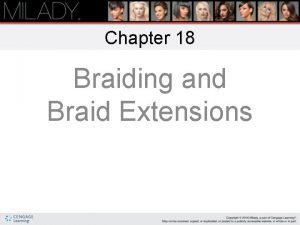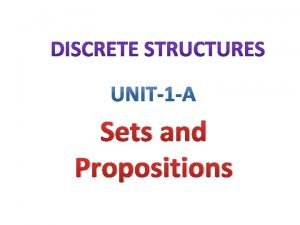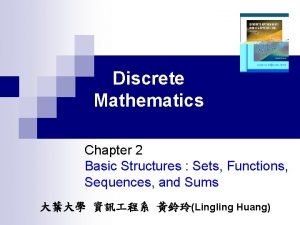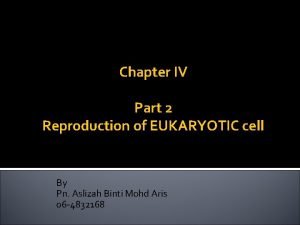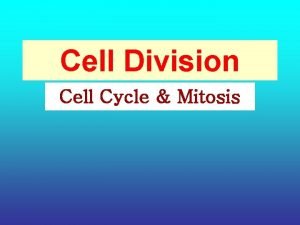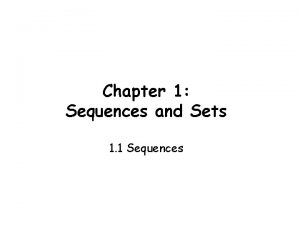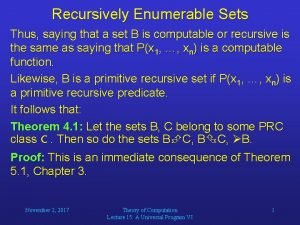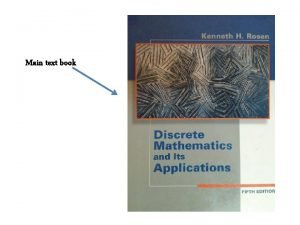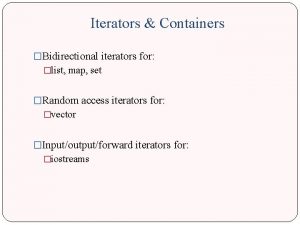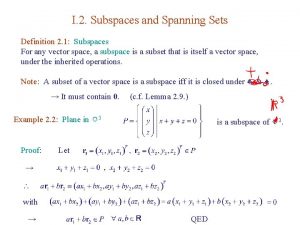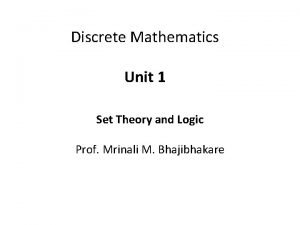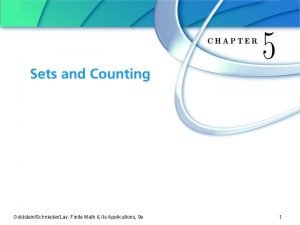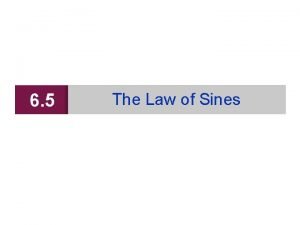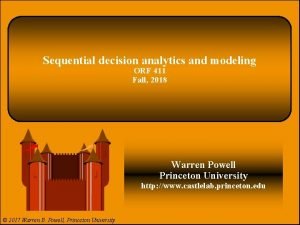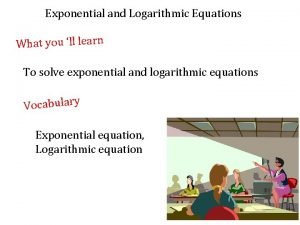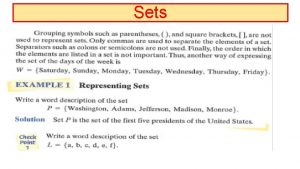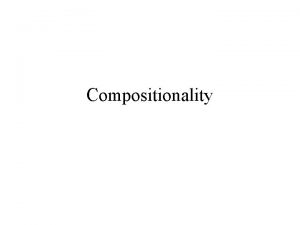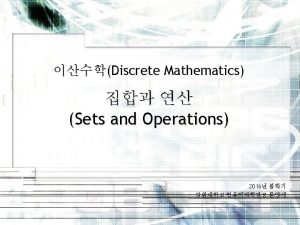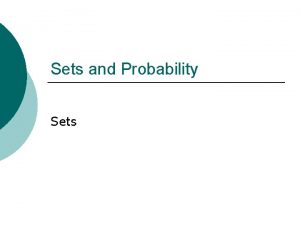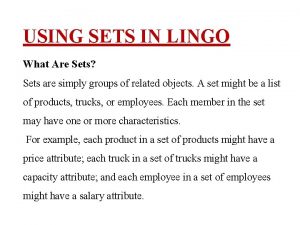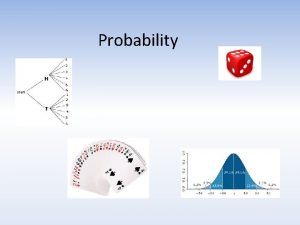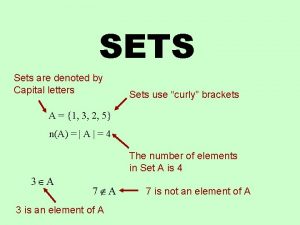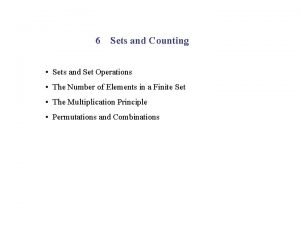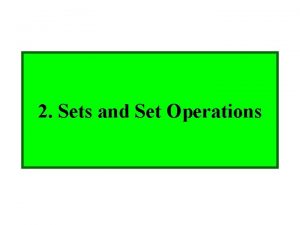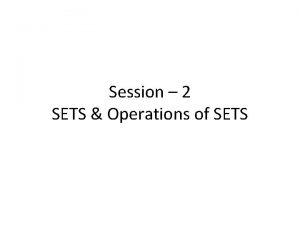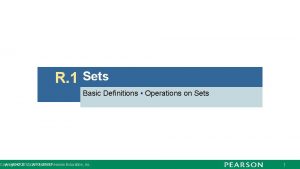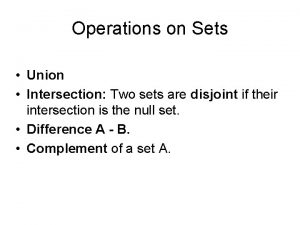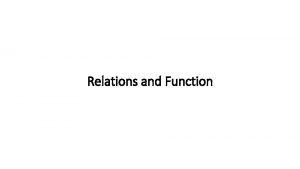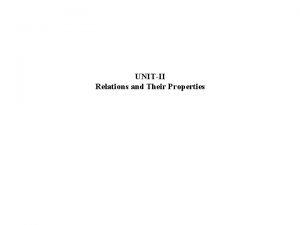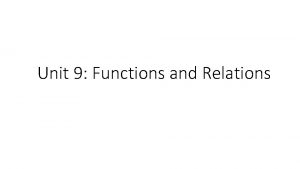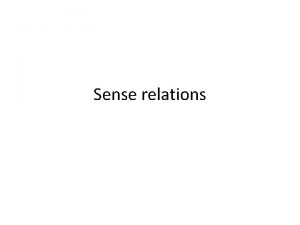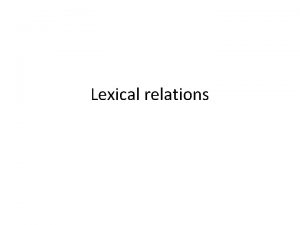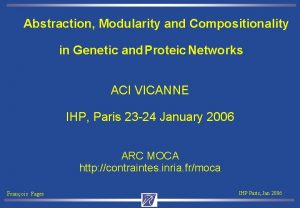MODELING COMPOSITIONALITY OPERATIONS AND RELATIONS ON SETS When

























- Slides: 25

MODELING COMPOSITIONALITY

OPERATIONS AND RELATIONS ON SETS When we use set concepts and terminology as a tool for interpreting sentences, we will often want to say something about the relationship between two sets, or to combine two or more sets in certain ways to define a new set. In order for this to be possible, we must assume that the elements of each of the sets under discussion are drawn from the same universal set. This universal set is referred to as U.

OPERATIONS AND RELATIONS ON SETS

SET INCLUSION/ SUBSETS (12) U = {1, 2, 3, 4, 5, 6, 7, 8, 9, 10} A = {3, 4, 6} B = {2, 3, 4, 5, 6, 7} B AA A �B Figure 13. 1: Set inclusion (the subset relation)

SET INCLUSION/ SUBSETS (13) a. {a, b, c} �{a, b, c, d, f} b. {a, b, c} ⊈ {c, d, f} c. {a, b, c} � {a, b, c} d. ⱯS (where S is a set), ∅ �S

INTERSECTION The intersection of two sets, written “A∩B”, is defined as the set consisting of all elements which are both members of A and members of B. We can illustrate this situation using the sets defined in (14). By comparing the elements in set A with those in set B, we see that the two sets share only the following elements in common: 3, 4, and 6; so A∩B = {3, 4, 6}.

INTERSECTION (14) U = {1, 2, 3, 4, 5, 6, 7, 8, 9, 10} A = {2, 3, 4, 6} B = {3, 4, 5, 6, 7, 8} (15) {a, b, c}∩{c, d, f} = {c}

UNION The union of two sets, written “AUB”, is the set consisting of all elements which are either members of A or members of B. Returning to the sets defined in (14), the union of the two sets is formed by combining all the elements from both, which yields the following result: AUB = {2, 3, 4, 5, 6, 7, 8}. Figure 13. 3 illustrates this in the form of a diagram, and another example in standard set notation is provided in (16).

UNION (16) {a, b, c} U {c, d, f} = {a, b, c, d, f}

COMPLEMENT The complement of set A, written as Ā or A′, is defined as the set which contains all the elements of U that are not elements of A. Some simple examples are shown in (17). Here, the only elements of U which are not in A are 1 and 5, so Ā = {1, 5}. Similarly, the elements of U which are not in B are 1, 2, 5, and 6; so Ḇ = { 1, 2, 5, 6}.

COMPLEMENT This basic notion of complement set involves complements relative to the universal set U. It is often useful to refer to the complement of one set relative to some other set. The complement of A relative to B, written “B–A”, is the set consisting of all elements which are members of B but not members of A. 6 Another way of expressing this definition is the following: B–A = B ∩ Ā. Figure 13. 4 illustrates this in the form of a diagram, and several examples in standard set notation are provided in (18).


OVERVIEW To summarize, we have defined three basic operations on sets (intersection, union, and complement or “difference”), and one relation between sets, namely inclusion (the subset relation). The three operations provide ways of combining two existing sets to define a new set. It is important to note that “AUB”, “A ∩ B”, and “B–A” are names of sets; but “A �B ” is a proposition, a claim about the membership of the two sets, which could be true or false. More precise definitions of set intersection, union, complementation, and inclusion (the subset relation) are provided in (19). These definitions will help us to understand, for example, why the interpretation of an “and” statement frequently involves the intersection of two sets while the interpretation of an “or” statement frequently involves the union of two sets.

OVERVIEW

TRUTH RELATIVE TO A MODEL Denotations, including the denotations of referring expressions and truth values of sentences, can only be evaluated relative to a particular situation of use. In order to develop and test a set of interpretive rules, which can correctly predict the denotation of a particular expression in any given situation. As stated above, this kind of description of a situation is called a model, and must include two types of information: (i) the domain, i. e. , the set of all individual entities in the situation. (ii) the denotation sets for the basic vocabulary items in the expressions being analyzed.

TRUTH RELATIVE TO A MODEL

TRUTH RELATIVE TO A MODEL

RULES OF INTERPRETATION Stating the truth conditions for individual sentences like those in Table 13. 1 is a useful first step, but does not yet replicate what speakers can do in their productive use of the language. Ultimately our goal is to provide general rules of interpretation which will predict the correct truth conditions for sentences based on their syntactic structure. As a further step toward this goal, let us return to the sentence in (21 a), which we have already discussed several times. (21) a. King Henry VIII snores. b. Anne Boleyn snores.

We have already stated an informal rule of interpretation for simple sentences: the proposition expressed by a (declarative) sentence will be true if and only if the referent of the subject NP is a member of the denotation set of the VP. We can now restate this rule in a slightly more formal manner. We will assume that the basic syntactic structure of the clause is [NP VP]. The semantic rule we wish to state operates in parallel with the syntactic rule which licenses this structure, as suggested in (22). (Recall that the semantic value, i. e. , the denotation, of a sentence is its truth value. ) (22) syntax: S → NPsubj VP semantics: The semantic value of a sentence is ‘true’ if the semantic value of the subject is a member of the set which is the semantic value of the VP, and ‘false’ otherwise; [S] = ‘true’ iff [NPsubj ] ϵ [VP]

The statement in (23) can be expressed in logical notation as in (24 a). This formula is a specific instance of the general rule for evaluating the truth of propositions involving a one-place predicate. This general rule, shown in (24 b), states that the proposition P(α) is true if and only if the entity denoted by α is an element of the denotation set of P.

Let us now add a few more vocabulary items to our simple model, calling the new version Model 1′. This revised model presumably reflects the early period of the marriage, ca. 1532– 1533 AD, when Henry and Anne were happy and in love. Note also that Thomas More had fallen out of favor with the king around this time.


Model 1′ includes some two-place (i. e, transitive) predicates, and should allow us to evaluate simple transitive sentences like those in (26). The denotation set of a transitive predicate like LOVE or ANGRY_AT is not a set of individuals, but a set of ordered pairs. Sentence (26 a) expresses the proposition stated by the logical formula in (27 a). The truth conditions for this proposition are stated in terms of set membership in (27 b): the proposition will be true if and only if the ordered pair �King. Henry VIII, Anne Boleyn�is a member of the denotation set of LOVE. Since this is true in Model 1′, sentence (26 a) is true with respect to this model. The formula in (27 b) is an instance of the general pattern stated in (27 c).


Thank you
 Helen erickson biography
Helen erickson biography Relational modeling vs dimensional modeling
Relational modeling vs dimensional modeling Employee relations in public relations
Employee relations in public relations Image sets
Image sets Milady chapter 18 review questions and answers
Milady chapter 18 review questions and answers What is data and process modeling
What is data and process modeling Modeling with quadratic functions
Modeling with quadratic functions Typical process description tools include
Typical process description tools include Sets and propositions in discrete mathematics
Sets and propositions in discrete mathematics Sets and functions in discrete mathematics
Sets and functions in discrete mathematics Chromosome sets (=n) in mitosis and meiosis
Chromosome sets (=n) in mitosis and meiosis Anaphase meaning
Anaphase meaning Sequences and sets
Sequences and sets Recursive and recursively enumerable sets
Recursive and recursively enumerable sets Finite and infinite sets
Finite and infinite sets Maps
Maps Maps and sets support bidirectional iterators.
Maps and sets support bidirectional iterators. Minimum spanning set
Minimum spanning set Sets and propositions in discrete mathematics
Sets and propositions in discrete mathematics Finite math
Finite math A pilot sets out from an airport and heads in the direction
A pilot sets out from an airport and heads in the direction Well defined objects
Well defined objects Simulation kelton
Simulation kelton Sequential decision analytics
Sequential decision analytics Modeling with exponential and logarithmic equations quiz
Modeling with exponential and logarithmic equations quiz Dfd chapter 5
Dfd chapter 5




